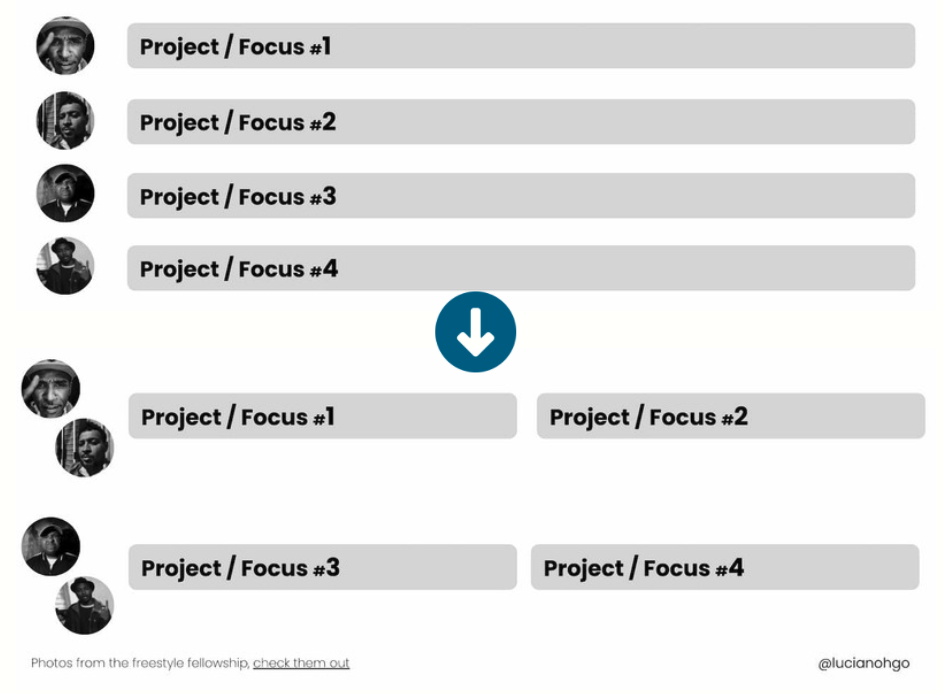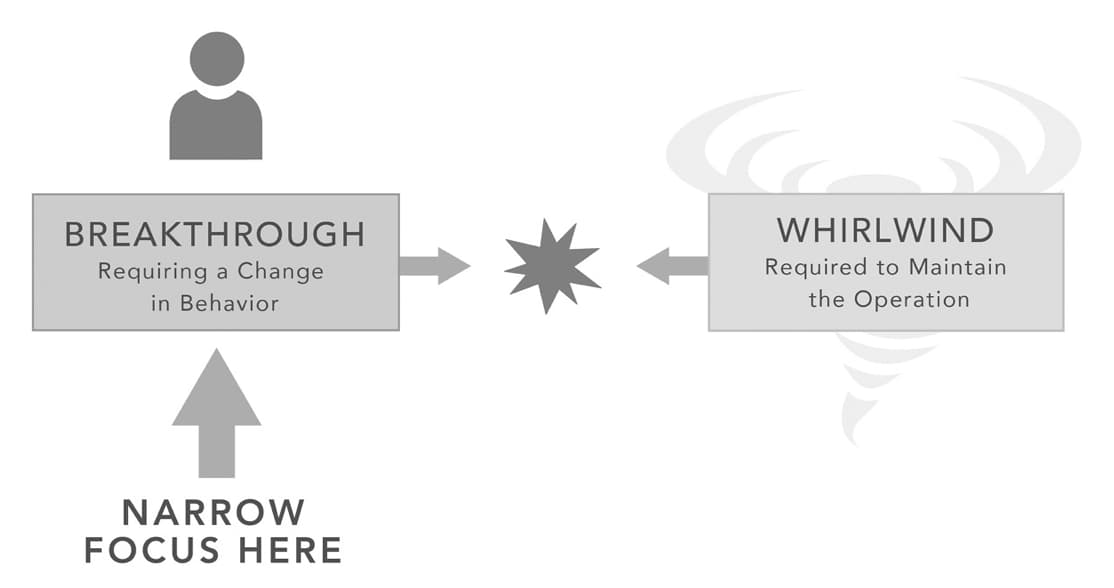Find Piece of Mind Taking One Thing at a Time
"What are your team's top priorities this quarter?" I asked. The candidate looked at me, eager to answer this question. "Our team's top priority is driving more users to convert into the product daily." He started. As he spoke, I could see his eyes moving while reading what probably was a document he had prepared to be able to answer this question. I didn't see why at that point, but I would soon find out.
"We want to lower our CAC by investing in making notifications the primary retargeting channel. Our team will also focus on increasing Conversion by removing some extra friction before the users convert [...]. Finally, since our NPS has been falling due to delayed customer service and we want more word-of-mouth, we're also experimenting with chatbots in the help section and optimizing support so that we retain our users." All of these projects seemed promising. But this was one quarter, six engineers. So I followed up: "How do you manage so many priorities at once?–" he was also thrilled to answer that question. "To create more ownership, we have different people owning each of the initiatives, so we have three initiatives and three people owning and driving each. It's a great way to develop leadership." We talked about the main struggles he was facing and shared that they had to stop frequently to deal with bugs caused by technical debt and that the team felt like they didn't have the time to tackle this technical debt. So he wanted to dedicate part of the team's time to pay that debt–yet another focus. If only he rewrote that legacy code and paid the debt, the model would work out great, he guaranteed. I wasn't so hopeful.
By now, you probably guessed the problem here is that there are too many focuses. In other words, there is no focus at all. Having no clear priority makes the team have too much work in progress. Besides the problem the candidate identified, there are quite a few others that are very common:
- The team doesn't collaborate. In this case, 3 to 4 different groups are working on different things. It's even worse than that because they have the overhead of communication. They need to hear what the others are doing even though they don't prioritize it. Peer-to-peer coaching suffers. ****The team doesn't leverage a balance of senior and junior engineers. When they have different goals, it's harder for them to join in and help out. It makes it hard for people to help and coach each other effectively.
- The context in the team becomes overbearing. Understanding all that is going on is very hard. Being effective at changing directions and identifying opportunities becomes increasingly tricky. When the context is hard to grasp and people don't have a clear path to look to, innovation suffers. People won't think of different ways to do things. Instead, they will focus on execution. It isn't clear to the team what's the purpose. The scope they propose is too limited because the team is divided.
 The evolution of teams that fail to prioritize. The second model is better because we have some collaboration, but it doesn't actually solve the problem
The evolution of teams that fail to prioritize. The second model is better because we have some collaboration, but it doesn't actually solve the problem
No matter how hard the team tackles the technical debt, the main problem isn't how horrible the legacy code is. Instead, the team doesn't have time and the headspace to think about quality and maintenance. The product and what the team built in the past will always be there. It will pile on and become larger each quarter. At the same time, the team needs to handle this increasingly complex Whirlwind, focus on 3 to 4 new initiatives and be creative about them. It's unrealistic. We're setting the team up to fail.
Focus is one of those topics that people are sure they have mastered yet fail to do. There are many reasons we end up with multiple goals but the most common one is "Stakeholder Driven Roadmaps." Instead of doing actual Product work, the team's leadership divides the engineering team into smaller groups to say yes to everything simultaneously and delegate the decision of what to focus on to stakeholders. Teams pile on and vouch that they will tackle many different changes, new initiatives, and breakthroughs because they feel obligated to. A desire to prove ourselves or a fear of saying "no" to people who have expectations on what we should build drives us to feel this obligation. By falling victim to this, we end up setting the team up for failure, or worse, burning the team out and still not meeting those expectations.
 Image and terminology took from the 4 Disciplines of Execution. Please read it. It's exceptional
Image and terminology took from the 4 Disciplines of Execution. Please read it. It's exceptional
The Solution
The simple but hard-to-pull-off solution is to have a single Wildly Important Goal (WIG). Some of you, at this point, are probably mumbling something about how nine pregnant ladies cannot make a baby in one month. I hear you. But teams who try to focus on too many new goals at the same time usually wind up doing a mediocre job on all of them. Although using this constraint–of having a single focus–makes it even harder, it makes execution so much better it warrants a try. You can ignore this constraint, but it won't ignore you. Goal setting and team structure aren't easy problems to solve. That's the hard part. So here are two good questions to help you with that defining what's more important:
- "If every other aspect of our team's performance remained at its current level, what is the one area where significant improvement would have the greatest impact?"
- "Where do we most want to create a breakthrough?"
 An effective team works together on a single Wildly Important Goal
An effective team works together on a single Wildly Important Goal
The Rules
In the book 4 Disciplines of Execution, the authors lay out rules for successfully using WIGs in organizations:
- Rule #1 No individual focuses on more than one WIG at a time. This limits that a single team cannot focus on more than one goal because the leadership in that team cannot focus on more than one goal. If you can't prioritize between goals, create separate teams who share are under an organization that has a shared top-level goal. If you can't create two separate teams, guess what? You can't tackle both goals.
- Rule #2 The Battles you choose must win the war. The only reason you fight a battle is to win the war. You don't fight a useless battle. Once we choose a WIG, we don't go for a complete list of what we can do. Instead, we ask ourselves: "what's the smallest number of battles necessary to win the war?" Simplify and clarify your strategy.
- Rule #3 Leaders of Leaders can veto but not dictate. People closest to the execution need to be deciding the WIGs for their teams. We can't simply hand down goals. Good goal-setting is a healthy mixture of bottom-up and top-down vision.
- Rule #4 All WIGs must have a finish line in the form of From X to Y by When. Everyone that shares that WIG needs to have a clear vision of the finish line and by when we want to reach it. The result needs to be measurable.
And that's it. It's not easy being ruthless about goal setting and prioritization like this, but it pays off. It pays off in clarity, collaboration, accountability, engagement, and effectiveness. With each new WIG that you reach, the organization creates new capabilities and can be bolder. So the next time you're setting goals, choose simplicity, choose focus and say no to everything else.
"You have to decide what your highest priorities are and have the courage—pleasantly, smilingly, unapologetically—to say no to other things. And the way you do that is by having a bigger "yes" burning inside."
– Stephen R. Covey